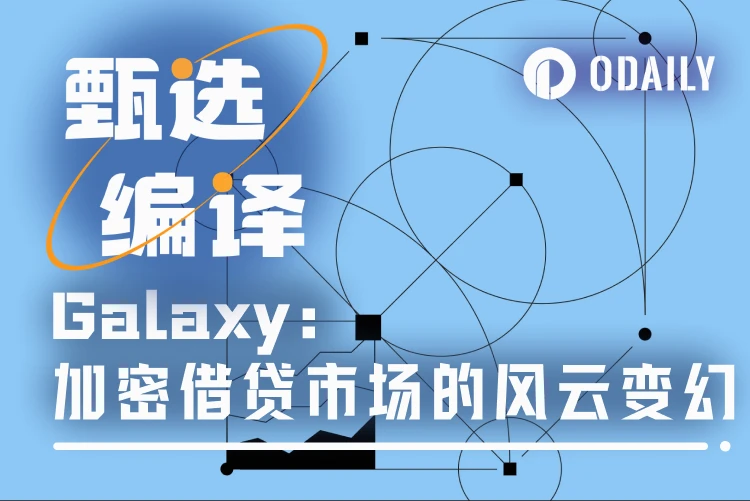Original article by: Zack Pokorny, Galaxy Research Analyst
Compiled by Odaily Planet Daily ( @OdailyChina )
Translator | Ethan ( @ethanzhang_web3 )

The State of Crypto Lending report was released by Galaxy Digital on April 14, 2025, and provides an in-depth analysis of the past, present, and future trends of the crypto lending market. Since the emergence of the cryptocurrency market, lending products have been integrated into the crypto financial ecosystem and are of great importance. Compared with traditional finance, crypto lending has shown extraordinary potential and innovation possibilities with decentralization and blockchain technology, but innovation and risks coexist, and the market development is ups and downs.
The report details the participants, market size and dynamics of crypto lending, digs deep into the risks, technical obstacles and regulatory situations faced, and focuses on comparing the two sub-markets of CeFi (centralized finance) and DeFi (decentralized finance), showing the differences, intersections and integration trends between the two. In addition, it talks about how to strike a balance between the freedom and transparency of DeFi and the stable supervision of traditional finance, which is still one of the key problems in the crypto lending industry.
Because the original text is long and contains many key points, in order to facilitate readers to quickly obtain core information, Odaily Planet Daily has edited it, taking the core content as the main line, extracting key points and summarizing key information.
Market Overview and Size
According to the report, the cryptocurrency lending market started in 2017 and reached a peak of $64.4 billion in 2021. However, by the fourth quarter of 2024, the total size of the market had dropped to $36.5 billion, a decrease of 43%. This change was mainly driven by multiple factors, especially cyclical fluctuations in the market and risk events such as platform bankruptcy.
As crypto asset prices plummeted and market liquidity dried up, some CeFi lenders with larger lending scales went bankrupt in 2022 and 2023. Most notably, Genesis, Celsius Network, BlockFi, and Voyager filed for bankruptcy in the past two years. This caused the total size of the CeFi and DeFi lending markets to plummet by about 78% from the peak in 2022 to the trough of the bear market, and CeFi lending lost 82% of its open borrowings.

Some of the major players in the CeFi and DeFi crypto lending market, past and present
Changes in CeFi and DeFi lending markets
The report analysis shows that there is a certain correlation between the shrinking CeFi lending market and the rise of the DeFi lending market. In the early stages of the cryptocurrency market, the CeFi lending market dominated, mainly dominated by some well-known platforms such as Genesis, Celsius and BlockFi. However, with the rise of decentralized finance (DeFi), the market share of CeFi lending platforms has gradually been divided, and the DeFi lending market has shown a stronger growth momentum.
CeFi lending market: As of the fourth quarter of 2024, platforms such as Tether, Galaxy, and Ledn still dominate the CeFi lending market, with total loans reaching US$9.9 billion, accounting for 88.6% of the CeFi market, which also accounts for 27% of the entire crypto lending market.
DeFi lending market: DeFi lending platforms have grown particularly rapidly, thanks to their decentralized governance model, transparency, and financial services without the need for intermediaries. Since $1.8 billion in the fourth quarter of 2022, the DeFi lending market reached $19.1 billion in the fourth quarter of 2024, an increase of nearly 10 times.
Influencing factors
The high volatility of the cryptocurrency market is one of the main factors affecting the crypto lending market. Especially during the cryptocurrency bull market in 2017 and 2021, the demand for lending surged and the market size expanded rapidly. In the bear market, due to the decline in the price of crypto assets, lending platforms faced huge liquidation pressure, resulting in the risk of capital chain rupture and bankruptcy for many platforms.
From 2022 to 2023, large CeFi platforms such as Genesis, Celsius, and BlockFi went bankrupt one after another, causing a sharp drop in the market. In particular, during the bankruptcy of Celsius, its debt of about $15 billion brought a huge impact to the market. In addition, the bankruptcy of these platforms exposed the lack of effective risk management mechanisms and transparency of many platforms in the crypto lending market, and also highlighted the urgent need for supervision and improvement of risk prevention and control measures in the crypto lending market.
The difference and integration between CeFi and DeFi lending
CeFi and DeFi lending platforms in the crypto lending market have significant differences in operating mechanisms, risk management, and user experience. The interaction and integration of the two will determine the future development pattern of the crypto lending market.
Features and Challenges of CeFi Lending
CeFi lending platforms are usually operated by centralized entities, similar to banks or credit institutions in traditional finance. These platforms tend to conduct strict credit assessment and risk control to ensure the repayment ability of loans, and conduct detailed classification and pricing of loan products.
Advantages: CeFi lending platforms usually provide higher liquidity and more stable loan products, which is especially important for risk-averse investors. The platform usually relies on traditional financial management methods to control risks and is able to operate within the regulatory framework, so it is safer.
Disadvantages: The centralized structure means that the platform has the risk of single point failure, especially in the absence of effective supervision. If the platform is poorly managed or has operational problems, it may lead to large-scale financial losses. In addition, the platforms centralized management of personal data and assets may lead to the risk of privacy leakage or abuse.
Features and Challenges of DeFi Lending
Unlike CeFi, DeFi lending platforms operate in a decentralized manner. All borrowing and lending operations rely on smart contracts for automatic execution, and users do not need to rely on any intermediary platform. This decentralized feature makes DeFi lending platforms more transparent and competitive in the market.
Advantages: The smart contracts of DeFi lending platforms guarantee decentralization and transparency, and users can check the flow of funds on the platform at any time. Since there is no centralized manager, the users data privacy is better protected. In addition, the interest rates of DeFi lending platforms are flexible and usually high, attracting a large number of investors seeking high returns.
Disadvantages: However, DeFi lending platforms still face technical risks, especially security issues such as smart contract vulnerabilities and cyber attacks. Due to the lack of legal protection, it is difficult for users to seek traditional legal assistance when encountering disputes. In addition, the liquidity of DeFi platforms may be affected by market fluctuations, resulting in insufficient liquidity.

The integration trend of CeFi and DeFi
Although there are significant differences in the way CeFi and DeFi lending platforms operate, as the market matures, the trend of integration between the two is becoming more and more obvious. Some CeFi platforms have begun to introduce decentralized technologies into their lending products, using blockchain technology to improve transparency, reduce costs, and enhance the security of the platform.
At the same time, some DeFi platforms have also begun to introduce CeFis risk management experience to improve the platforms user experience and service quality. For example, DeFi platforms have introduced new insurance mechanisms, custody services, and compliance tools to increase user trust and enhance the security and stability of the platform. In the future, with the advancement of technology and further development of the market, CeFi and DeFi lending platforms may gradually find a balance and give full play to their respective advantages.
Conclusion and Thoughts
Judging from market trends, the rise of DeFi lending has the potential to reshape the entire crypto-financial ecosystem. It not only changes the way lending is done, but also provides users with more competitive interest rates and greater transparency. However, to truly replace CeFi, DeFi lending platforms must make more efforts in technology, network security, and regulatory compliance.
In general, the current status of the crypto lending market shows a financial ecosystem full of opportunities and challenges. The transition from CeFi to DeFi reflects the trend of the financial market gradually moving towards decentralization. However, as the market develops, problems and risks are gradually emerging. Problems such as platform bankruptcies and lagging supervision warn us that decentralization does not mean completely risk-free, and the market still needs to find a healthier and more sustainable development path.










